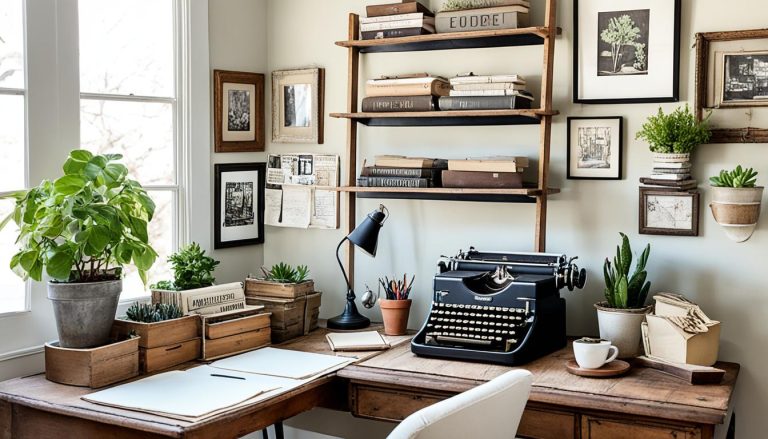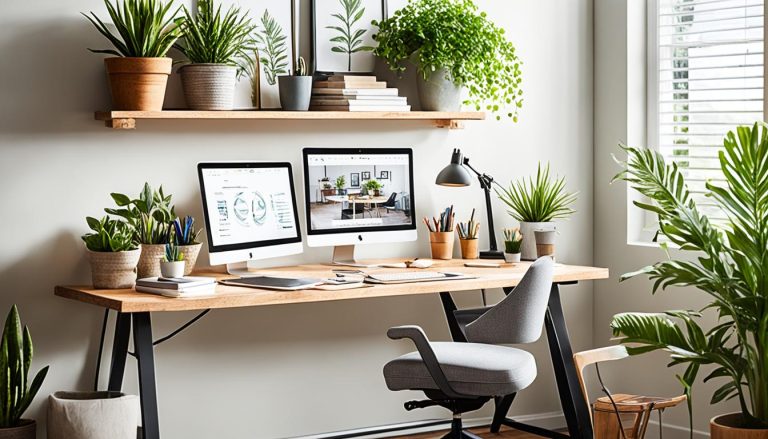Home Office Design for Remote Learning: Tips & Ideas
houseremodelingnews.com may earn a commission if you purchase a product through one of our links
“The secret of change is to focus all of your energy not on fighting the old, but on building the new.” – Socrates
Remote learning is now common, making a good home office design key. With 90% of remote workers wanting to stay home, it’s time to update your space. Whether for kids’ study rooms or virtual learning setups, the right design helps a lot.
Imagine having three work areas in one home office, along a window wall. This setup is both ergonomic and bright, helping with focus and mood. Studies show that good lighting cuts down eye strain and improves focus during long Zoom meetings.
Details matter, like vintage school lockers for storage and styluses for digital tasks. A tidy workspace boosts productivity. Are you ready to create a home office that encourages learning and growth?
Creating an Ergonomic Workspace
Setting up ergonomic workstations is key for online learning. More people work from home now, making comfy and efficient home offices a must. Let’s see how to make a space that helps you work better and keeps you healthy.
Choosing the right chair
Your chair is the core of your ergonomic setup. Find one with adjustable parts like lumbar support, height, and armrests. These features help keep your spine straight and ease strain during long study times.
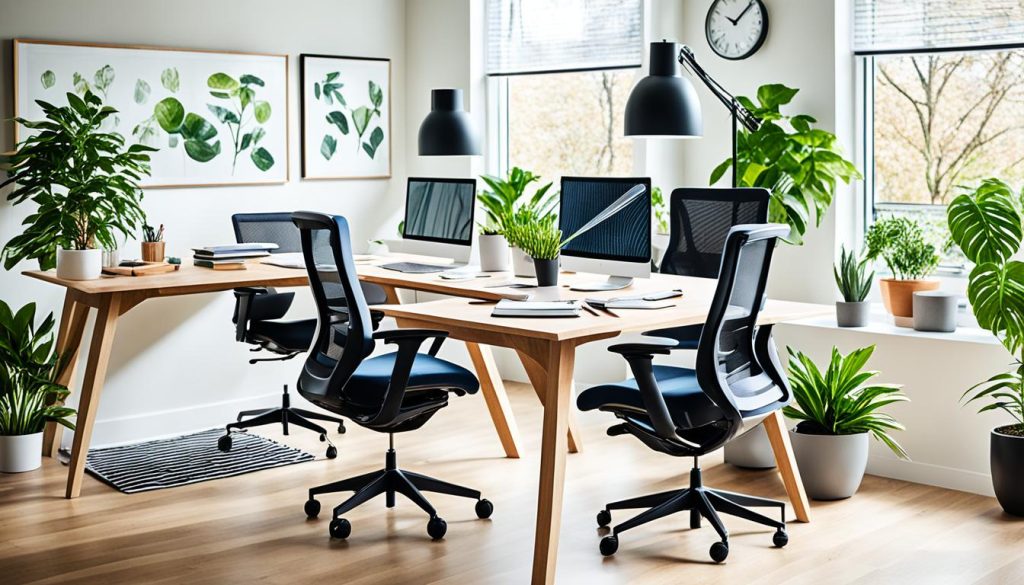
Proper desk height and positioning
Height-adjustable desks are becoming more popular as they help you work better. They let you switch between sitting and standing, which is good for your posture and blood flow. Make sure your desk is set so your keyboard and mouse are at elbow level when you sit.
Ergonomic accessories for comfort
Here are some ergonomic accessories to add to your online learning setup:
- Laptop stand: Raises your screen to eye level
- External keyboard: Allows for proper arm positioning
- Ergonomic mouse: Reduces wrist strain
- Task lighting: Minimizes eye fatigue
Creating an ergonomic workspace is investing in your health and success in school. By following these tips, you’ll make a space that supports your learning and boosts your productivity.
Maximizing Natural Light and Lighting Solutions
A well-lit home office is key for remote work. Natural light boosts productivity and well-being. Place your desk near a window to use daylight effectively. This simple step can change your workspace and improve your mood.

- Use desk lamps for focused task lighting
- Place table lamps on both sides of your desk to reduce shadows
- Install LED lights for energy-efficient, long-lasting illumination
- Try smart lighting systems to adjust color temperature throughout the day
Good lighting is crucial for video calls, a common part of remote work. It makes you look good on camera and reduces eye strain during long calls.
“After revamping our office lighting with natural light and LEDs, we saw a 20% increase in productivity and significant energy savings.”
A well-lit remote work space is more than just bright. It’s about creating a space that supports your body’s natural rhythms and helps you focus. By mixing natural and artificial light, you can make an ideal home office that boosts your productivity and health.
Organizing Your Digital Workspace
A well-organized digital workspace is key to successful remote learning. Let’s explore ways to streamline your online learning environment and boost productivity.
Essential Software for Remote Learning
Equip yourself with the right tools for a smooth online learning experience. Video conferencing setups are crucial for virtual classrooms. Choose platforms that offer features like screen sharing and breakout rooms. Invest in a reliable learning management system to keep track of assignments and deadlines.
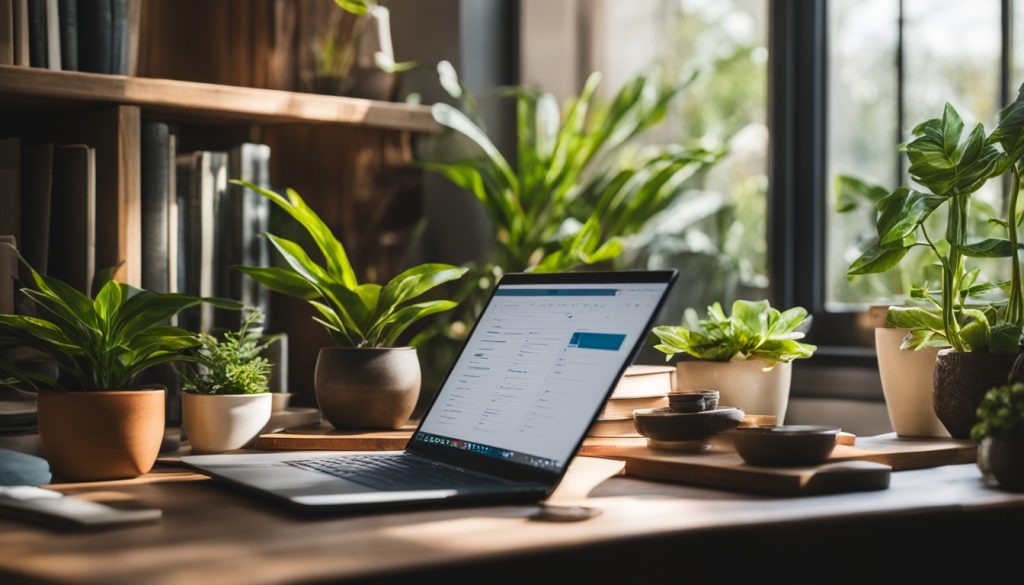
Managing Digital Files and Resources
Declutter your digital space to enhance focus. Create a system of four manageable piles for your digital documents: Action, File/Scan, Delete, and Archive. Set up a virtual filing system using cloud storage for easy access across devices. Dedicate time each day to sort through one digital pile, maintaining an organized workspace.
Creating a Virtual Classroom Environment
Transform your digital space into an inspiring virtual classroom. Use productivity hacks like digital whiteboards for collaborative brainstorming sessions. Customize your background during video calls to create a professional atmosphere. Incorporate online learning workspace inspiration by using virtual sticky notes or mind-mapping tools to visualize complex concepts.
- Use cloud storage for easy file access
- Implement consistent file naming conventions
- Utilize digital collaboration tools
- Set up a virtual filing system
Remember, an organized digital workspace not only boosts productivity but also reduces stress. Tailor these strategies to fit your personal learning style and watch your remote learning experience transform.
Designing a Distraction-Free Environment
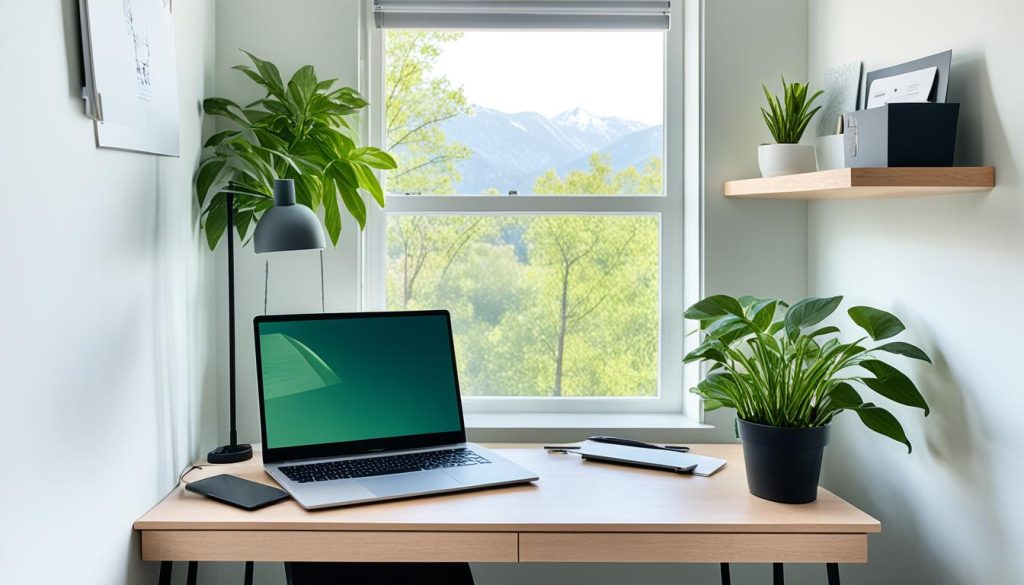
Creating spaces without distractions is crucial for learning online. With the right designs, any area can become perfect for studying. First, pick a spot for studying away from noise and distractions at home.
Noise-canceling headphones are a must for blocking out background sounds. They’re vital for staying focused, even in loud homes. Also, use website blockers to keep social media and other distractions away during study time.
Keep your study area clean and organized. A neat space helps keep your mind clear and focused. Here are some tips for setting up your study space:
- Invest in proper storage solutions to keep materials organized
- Use room dividers or screens to separate your work area from living spaces
- Optimize natural lighting to enhance mood and productivity
- Choose ergonomic furniture to support long study sessions
Talking to your family is important. Tell them about your study schedule and the need for quiet during those times. With these steps, you’ll make a space that helps you focus on your online classes.
“A well-designed workspace is the foundation of productive remote education.”
Incorporating Storage Solutions
Smart storage is key for keeping a home classroom or workspace tidy. A well-planned study room can increase productivity and make learning fun. Let’s look at some creative ways to organize your remote learning area.
Shelving and Bookcase Ideas
Use floating shelves or bookcases to make the most of vertical space. These solutions help keep your study stuff organized and within reach. With E% of home offices showing off personalized decor, you can display your favorite books and motivational items too.

Desk Organization Tools
Keep your desk clear with smart organizers. Desk organizers, trays, and dividers help sort pens, notebooks, and gadgets. This keeps your workspace neat, letting you focus better on your studies.
Hidden Storage Options
If you’re short on space, hidden storage is a lifesaver. Think about furniture with built-in compartments. About F% of small home offices use sliding barn doors to save space and keep things private. These doors can hide storage when not needed, keeping your study room looking neat.
Having an organized space helps keep your mind clear. With these storage tips, you’ll set up a productive and welcoming space for remote learning.
Soundproofing and Acoustics Optimization
Creating a distraction-free zone for remote learning starts with making your home office quiet. It should be a place where you can focus and learn well. Let’s look at ways to make your workspace sound better.
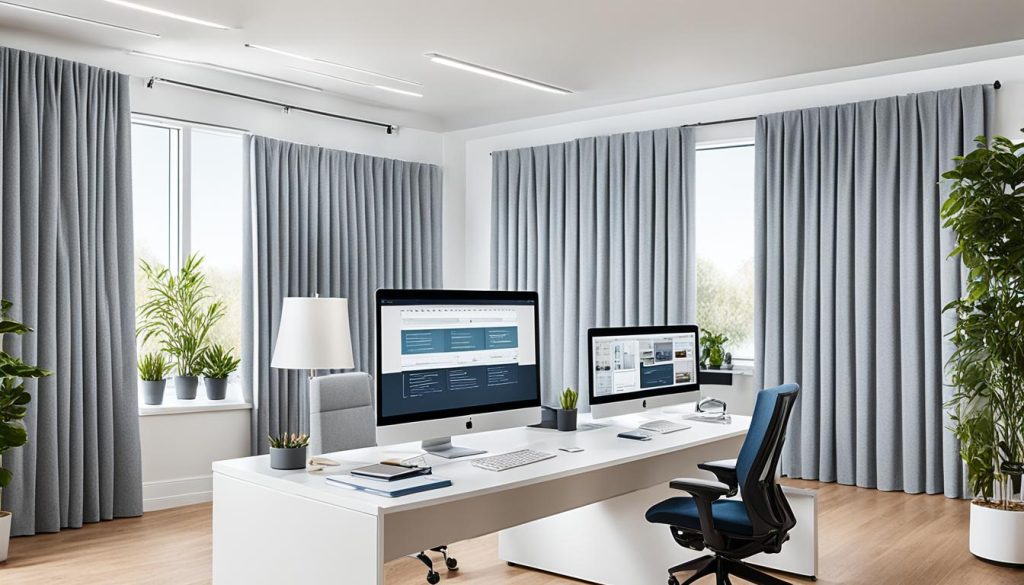
Start by picking a study spot away from loud noises outside and inside. Put in heavy doors with seals and add weatherstripping to block outside sounds. These changes can make your learning area much quieter.
To soak up sound, think about adding soft furniture like beanbags or cushions. These items help reduce echoes and make your space more comfy. You can also use acoustic panels to soak up sound waves.
- Use rugs or carpets to dampen floor noise
- Hang curtains or drapes to reduce echo
- Place bookshelves against walls to absorb sound
Invest in noise-canceling headphones for focused work or online meetings. They help create a quiet space, even if you’re in a shared area with others.
If you’re watching your budget, try making your own acoustic panels. Use foam, fabric, and wood frames for these. For ongoing background noise, a small fan or sound masking can help block out sounds from other parts of your home.
“Speech intelligibility in classroom environments is crucial. Excessive background noise can negatively impact learning, especially for ESL, speech-impaired, and neurodiverse students.”
By using these tips for better sound quality, you’ll make a great space for remote learning. This will help you stay focused and productive.
Home Office Design for Remote Learning
Designing your home office for remote learning is key today. With more students learning online, having a well-organized home office is vital. Let’s look at some important tips to make your online learning space better.
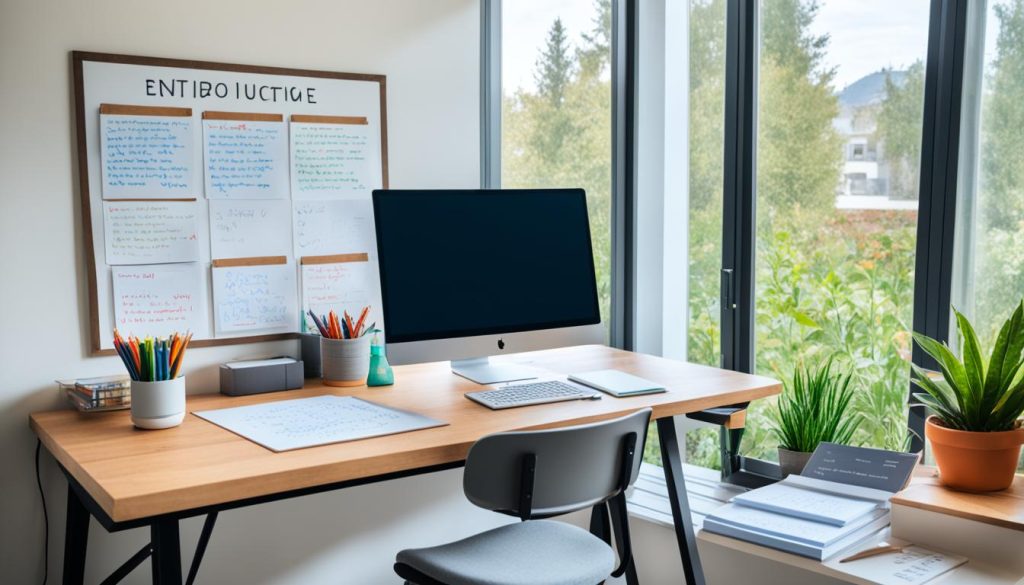
First, pick a spot for your home office. Put your desk near a window to get natural light. This helps you work better and look good on video calls. Think about using woven wood shades or faux wood shutters to control the light and keep a professional look.
Here are some things to add to your home office:
- A whiteboard or bulletin board for keeping things organized
- Good lighting for video calls
- Special storage for books and materials
- Dual monitors for better multitasking in online classes
Use colors to help organize and clean up. Make sure your workspace is away from toys and distractions. For small areas, think outside the box and use corners, nooks, or big foyers for your study space.
“72% of office workers prefer working from home at least two days a week, even after the pandemic.”
Remote work is becoming more common. So, making your home office for remote learning a good investment is smart. Follow these tips to create a space that helps you work well and succeed in your online classes.
Personalizing Your Workspace
Your home office should show off your personality and motivate you to work well. People spend up to 40 hours a week here, so it’s key to make a space that gets you going.
Inspirational Decor Ideas
Decor ideas can turn your workspace into a creative spot. Think about adding a DIY memo board made from remesh, spray-painted with Krylon Rose Gold. It’s useful and adds beauty to your office.
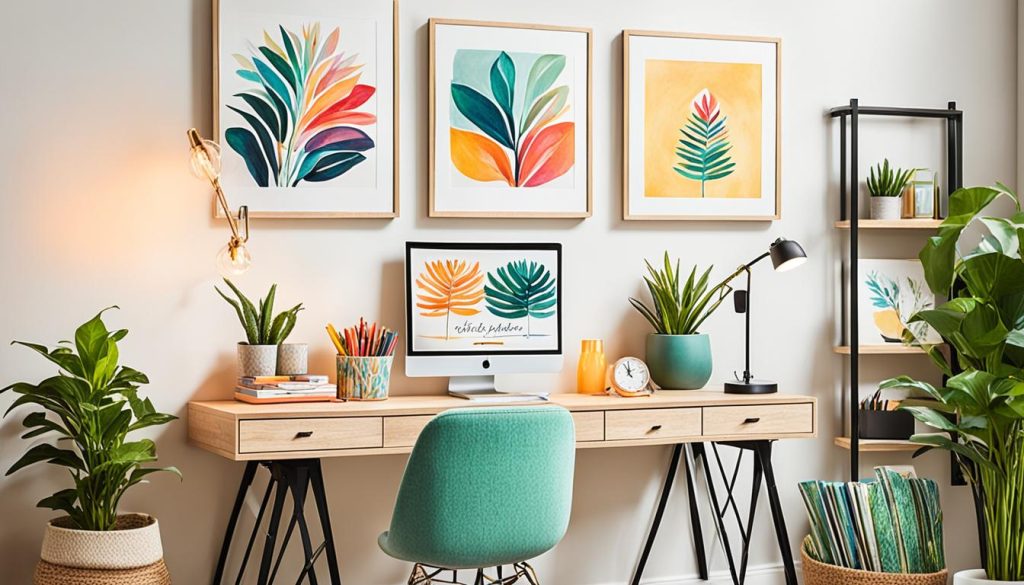
Incorporating Personal Touches
Make your space your own with things you love. Use cardstock and Command Picture Hanging Strips to make a calendar you can update every day. It keeps you on track and adds a personal touch to your desk. Many remote workers add personal decor to boost their motivation.
Creating a Motivational Atmosphere
Inspirational decor and art can really help you work better. Add a vision board or colorful stationery to spark your creativity. Studies show that a motivating workspace can make you more productive. Your office should be a place that helps you reach your goals and stay focused all day.
“Your workspace is a reflection of your mind. Keep it inspiring, and your ideas will flourish.”
By adding these personal touches, you’re not just decorating. You’re making a space that supports your success and well-being during remote work hours.
Tech Essentials for Remote Learning
Remote learning is now a common part of school for many students. To do well in this online setting, having the right tech gadgets is key. Let’s look at some essential tools that can improve your learning online.

A strong, fast internet connection is the base of good remote learning. With 56% of schools offering online classes, a reliable internet means you can join video calls and access online materials without trouble. If your internet is slow, think about getting a better plan.
For virtual classes, having the right video conferencing tools is a must. A good webcam helps you connect better with teachers and friends. Last year, 89% of teachers taught online for the first time, so clear communication is more crucial than before.
- Invest in a good microphone for clear audio
- Use a second monitor to enhance multitasking
- Try a document camera for sharing physical materials
The HP ENVY Laptop 16 is a great pick for online students. It has a powerful 12th Generation Intel® Core™ processor and a display that shows colors accurately. Plus, it lasts up to 9 hours and 45 minutes on a single charge, so you won’t run out of power during class.
Think about your comfort and how you’ll set up your study space too. The HP M24f FHD Monitor is great for long study sessions with its anti-glare feature. Add the Poly Voyager 4310-M Headset for clear audio in virtual classes.
“The immediate switch to virtual learning was hectic, but some teachers prefer this option.”
With these tech tools, you’ll be ready to face the challenges of online learning and get the most out of your digital education.
Balancing Comfort and Productivity
Creating an ergonomic workspace is crucial for boosting your productivity in your online learning space. Your home office should mix comfort with efficiency. This helps you perform better during remote studies.
Comfortable Seating Options
Invest in a chair that supports good posture. An adjustable ergonomic chair can make a big difference. For variety, try a balance ball chair or a standing desk. These options encourage movement, which can improve your focus and energy.
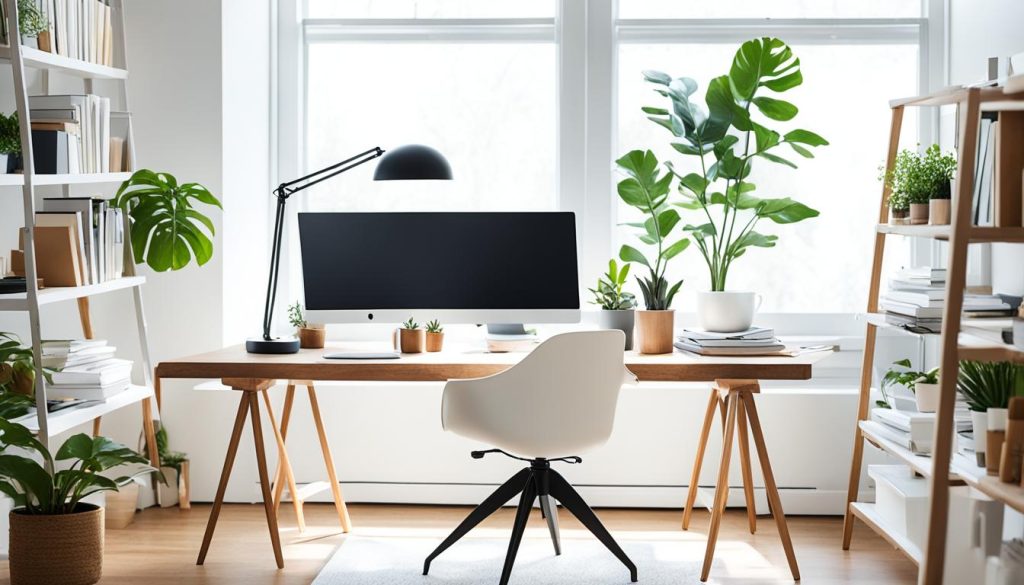
Temperature Control Tips
Keep your study area at a comfortable temperature. Aim for 70-72°F (21-22°C) to stay alert and focused. Use a small fan or space heater to adjust the temperature as needed. Proper temperature control can greatly affect your productivity.
Incorporating Plants for a Calming Atmosphere
Add some greenery to your workspace. Plants improve air quality and create a calming atmosphere. A few well-placed plants can reduce stress and boost your well-being. This leads to better productivity in your online learning space.
“A well-designed ergonomic workspace can increase productivity by up to 25%.”
Your home office setup should change with your needs. Regularly check and adjust your workspace to keep a balance between comfort and productivity. This approach will help you get the most out of your remote learning experience.
Adapting Small Spaces for Remote Learning
Remote learning is now common, with 98% of schools offering online classes. If you’re finding it hard to make a study area in a small home, don’t worry! We have some ideas to help you use your space well.
Wall-mounted desks are great for saving space. They can fold down and hide away when not in use. Adding floating shelves above the desk provides extra storage. This keeps your supplies organized without taking up floor space.
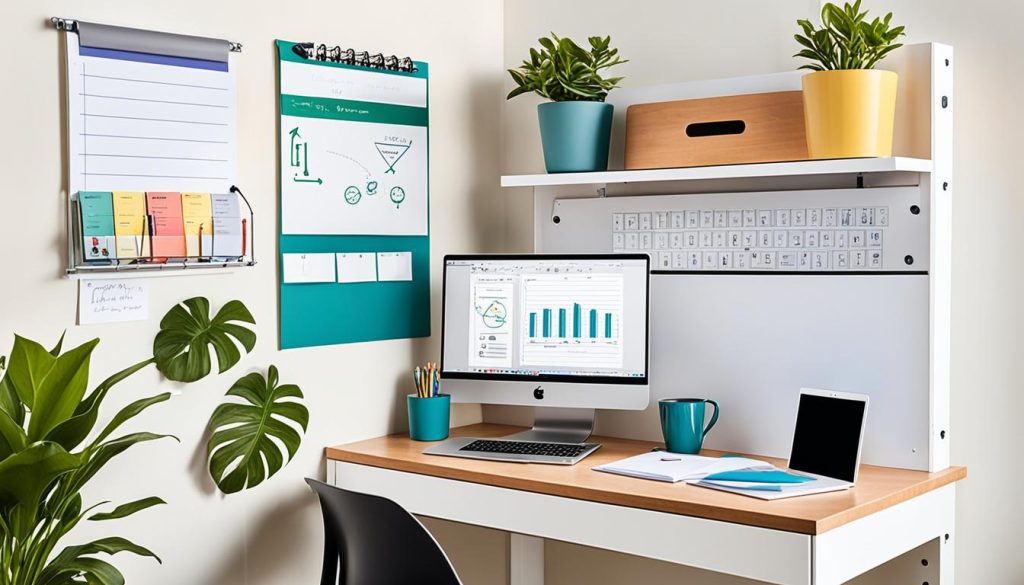
Keeping your desk simple is important in small areas. Pick a few items that inspire you to decorate the space. A small plant or a motivational quote can add charm without using much space.
Corner desks are also a smart choice for small areas. They fit perfectly into unused corners, making the most of every inch. Make sure to have a comfortable, adjustable chair for long study times.
Having a dedicated study area can improve your grades by 67%. Even in small homes, it’s important to have a consistent place for learning. With these ideas, you can create a useful and inspiring spot for remote learning, even with limited space.
Creating a Multi-Functional Space
Remote work has made us look for multi-functional spaces in our homes. With smart design, you can make an area that changes with your needs all day.
Dual-purpose furniture ideas
Choose furniture that serves two purposes to use your space better. A dining table can also be a desk, or a daybed can be for sitting and guests. These pieces make your space flexible, moving easily from work to personal time.

Transitioning between work and personal time
Make a routine to keep work and leisure separate. After work, put away your office stuff and turn your space back into a living area. This action marks the end of work and lets you relax at home.
Shared space solutions for families
For families in a shared space, talking is important. Make a schedule for using common areas and set areas for each family member. Use dividers or screens for privacy when needed. This keeps everyone productive and happy in the shared space.
“A well-designed multi-functional space can adapt to your changing needs throughout the day, supporting both work and relaxation.”
The aim is to have a space that moves easily between different uses. With smart design and shared solutions, you can use your home well, even if it’s small.
Establishing a Productive Routine
Creating a solid routine is key to boosting productivity in your remote work space. Studies show that 56% of people recognize the importance of routines for enhancing output. To set yourself up for success in your online learning environment, try these productivity hacks:

Start by setting consistent work hours. Arrive five minutes early to check your internet connection and audio-visual setup. This small step ensures you’re ready to engage fully in your virtual classroom.
Prioritize your tasks effectively. 65% of individuals number their top three crucial items on their to-do list. This method helps you focus on what’s most important in your online learning environment.
- Set realistic goals to avoid stress
- Use structured breaks to maintain focus
- Incorporate daily movement for mental health
Remember to establish boundaries in your remote work space. 75% of people recommend clear verbal communication followed by physical boundaries. This practice helps maintain a productive flow and separates work from personal time.
“A well-structured routine is the foundation of productivity in any remote work space.”
Lastly, don’t forget to exit your virtual classroom calmly. This courtesy ensures you don’t miss important information and avoids disturbing others still engaged in discussions. With these productivity hacks, you’ll create an efficient online learning environment that works for you.
Budget-Friendly Home Office Ideas
Creating a budget-friendly home office doesn’t mean you have to give up style or function. With smart planning and creative ideas, you can make a productive workspace without spending a lot of money.
DIY Desk and Storage Solutions
DIY desk solutions are a great way to save money and customize your space. You can turn an old dresser into a standing desk or use a closet as a compact workstation. Use affordable materials like plywood or repurposed pallets to build custom shelves for extra storage.

Affordable Tech Upgrades
Upgrading your tech doesn’t have to be expensive. Look for refurbished electronics or budget-friendly alternatives to pricey equipment. A portable Bluetooth speaker like the Anker Soundcore ($26.99) can improve your audio. For lighting, the ZEEFO Simple Table Lamp ($20.99) offers soft light without costing a lot.
Repurposing Existing Furniture
Be creative with what you already own. Turn a dining table into a spacious desk or use a bookshelf as a room divider and storage unit. Add casters to an old side table for a mobile file cabinet. These simple changes can save you money and make your home office functional.
“Most people spend a significant portion of their day at work. A well-designed home office can increase productivity, boost creativity, and reduce stress levels.”
A clutter-free workspace means fewer distractions and more productivity. Spend time organizing your space and see your efficiency improve. With these budget-friendly ideas, you’ll have a professional and comfortable workspace without spending too much.
Final Thoughts
Creating a great home office for remote learning is a journey of ongoing improvement. You’ve learned about many important factors, like ergonomics and lighting, and how to organize and personalize your space. By using these tips, you’re getting closer to making your online learning space more productive.
Your home office should show off your unique style and needs. Feel free to try out different layouts and decor until you find what suits you best. With 69% of companies thinking about keeping remote work long-term, making your workspace better is key.
Small changes can make a big impact in your home office. Adding a plant for some greenery, improving your lighting, or organizing your digital files can all help. Each change makes your learning space more inspiring and efficient. With the right setup, you’ll be ready to handle your remote learning tasks and do well in the digital classroom.



